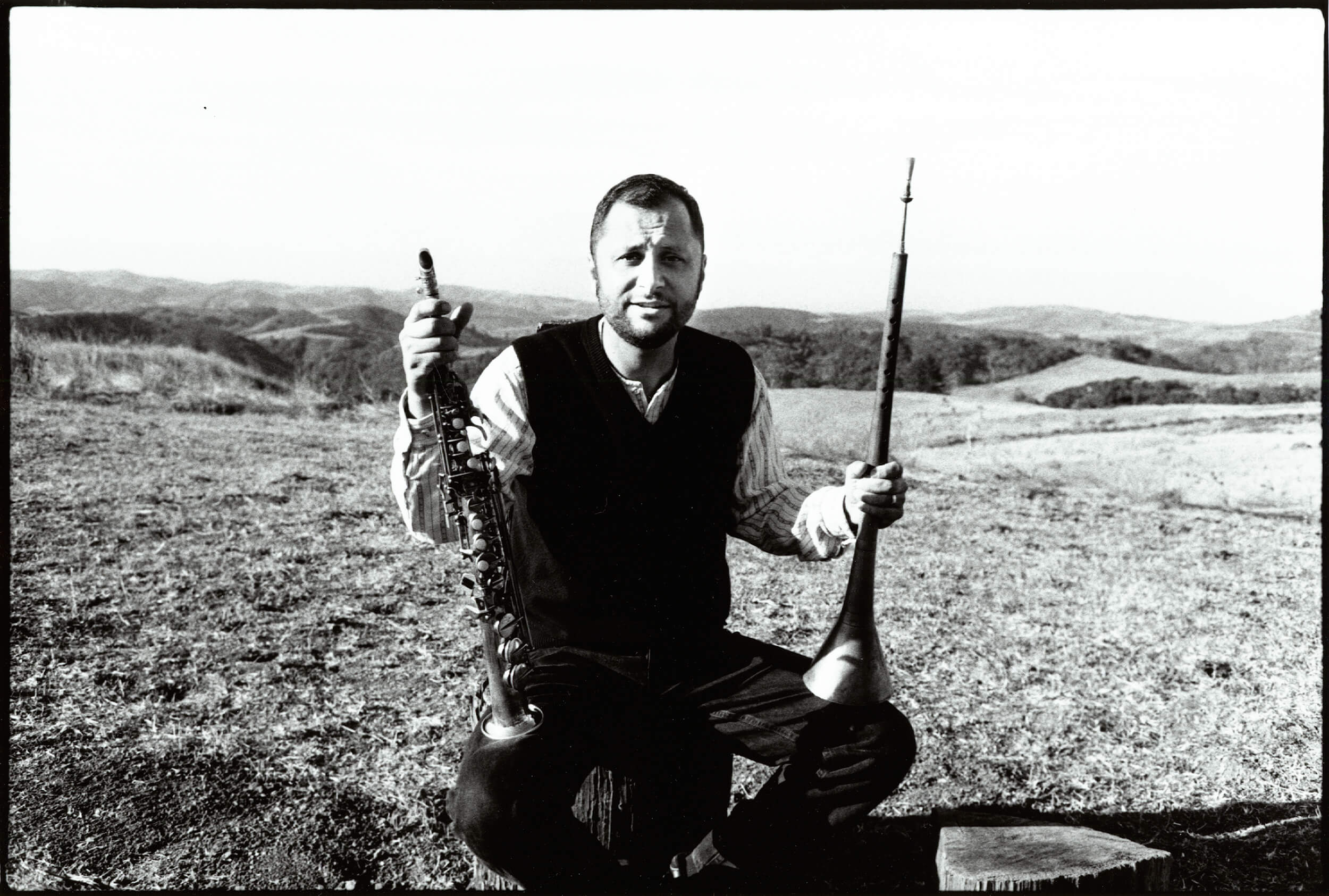
Retrospective by Other Minds Executive and Artistic Director, Charles Amirkhanian
(to come)
Artist Bios
Paul Dresher is an internationally active composer noted for his ability to integrate diverse musical influences into his own coherent and unique personal style. He pursues many forms of musical expression, including experimental opera and music theater, chamber and orchestral composition, live instrumental electro-acoustic chamber music performances, and scores for theater, dance, and film. His performances utilize progressive contemporary music technology and the theatrical works use the resources of experimental theater to examine diverse issues in contemporary American culture. As Artistic Director of the Paul Dresher Ensemble, he has guided the creation of the American Trilogy, a set of music theater works which address different facets of American culture, in collaboration with writer/performer Rinde Eckert.
Dresher is a fellow in the Asia Pacific Performance Exchange at UCLA where he is collaborating with Chinese director and singer Chen Shi Zheng in the creation of the experimental opera/dance theater work The Myth of The Hero. Dresher’s commissions have included works for the Saint Paul Chamber Orchestra, the Spoleto Festival USA, Kronos Quartet, the San Francisco Symphony, Margaret Jenkins Dance Company, ODC San Francisco, and the American Music Theater Festival. Recordings of Dresher’s works have been released on the Lovely Music, Music and Arts, New Albion labels, New World and Minmax labels. Born in Los Angeles in 1951, Dresher received his B.A. in Music from UC Berkeley and his M.A. in Composition from UC San Diego where he studied with Robert Erickson, Roger Reynolds, Pauline Oliveros, and Bernard Rands. His long-running interest in the music of Africa and Asia led him to study Ghanian drumming with C.K. and Kobla Ladzekpo, Hindustani classical music with Nikhil Banerjee, as well as Balinese and Javanese music.
A leading figure of Japan’s postminimalism movement, Mamoru Fujieda was born in 1955 and first studied composition at the Tokyo College of Music, then received his Ph.D. in music from University of California, San Diego in 1988. Fujieda is internationally recognized as one of music’s outstanding younger composers. Working with artists such as John Zorn, Yuji Takahashi, and Malcolm Goldstein, he composes music that emerges from his fascination with the essentially collaborative formation of music. Fujieda has developed methods of composition that depart from the minimalist tradition, charting a new terrain that liberates music from subjectivity by immersing it in a network of relationships.
Among his numerous methods, he has pioneered a new structure of composition that he calls “parasitic,” since it consists of grafting new material onto a “rhizome” of original melody borrowed from sources such as Bach, Gregorian chant, or medieval secular music. Whether working with the Butoh dancer Setsuko Yamada to produce sound sculptures that emerge from a mutual reaction between the dancer and objects that she touches, or reading the minute electrical currents flowing through an orchid to express nature’s undulations, Fujieda’s work represents an innovative approach that fuses technology to biology, composer to performer, and music to audience. His The Night Chant and the first six collections of Patterns of Plants appear on the TZADIK label.
Carl Stone, born in Los Angeles and now living in both California and Japan, is a former student of Morton Subotnick and James Tenney at the California Institute of the Arts and has composed electro-acoustic music exclusively since 1972. Hailed by the Village Voice as “one of the best composers working in the country today,” his works have been performed across the country and throughout the world. His most recent tour in Japan included concert, radio, and television appearances. A winner of numerous awards, including the Freeman Award for his work Hop Ken, Stone was also the recipient of a National Endowment for the Arts grant for his radiophonic composition Se Jong.
Stone’s music has been used by numerous choreographers, including Bill T. Jones, Ping Chong, June Watanabe, Katsuko Orita, and Blondell Cummings. Collaborations include those with Yuji Takahashi, Setsuko Yamada, Kazue Sawai, Aki Takahashi, Kuniko Kisanuki, Michiko Akao, Rudy Perez, Stelarc, Z’ev, Bruce and Norman Yonemoto, Tosha Meisho, Yoshihide Otomo, Hae Kyung Lee, Min Xiao-Fen, and Mineko Grimmer. Stone currently hosts a weekly program on KPFA and makes regular appearances on radio in Japan. Recently Stone was appointed Guest Artistic Director of Other Minds for its 1900-2000 season, temporarily replacing Charles Amirkhanian, who is in residency at the Rockefeller Foundation in Bellagio, Italy until September, 2000. Recordings of Stone’s music can be found on New Albion, CBS Sony, Toshiba-EMI, EAM Discs, Wizard Records, Trigram, T:ME/EM:T, and New Tone labels.
Saxophonist and composer Hafez Modirzadeh has collaborated with the likes of Don Cherry, Peter Apfelbaum, and Fred Ho, and has been recorded on more than a dozen releases, including the seminal 1993 In Chromodal Discourse and the critically acclaimed 1996 work The People’s Blues, as well as the soundtrack for the Mirimax film release of Kevin Spacey’s Albino Alligator. His invention of the “chromodal” method allows for a nonlinear improvisational practice which is able to adapt and incorporate multiple systems of music, permitting a cross-cultural “conversation” between instruments, performers, and musical idioms. Born in 1962 of an Iranian father and European-American mother, Modirzadeh grew up in France and the U.S., identifying strongly with African-American blues and jazz as well as the rich traditions of classical Iranian music. Today, he is a renowned scholar in ethnomusicology, whose writings have been published in numerous journals, as well as in his book The Chromodal Approach to Improvised Music (Spartan Books Press, 1996). He is the recipient of two NEA Jazz Fellowships as well as an Artist-in-Residence Grant from the California Arts Council.
Henry Brant is considered to be one of the principal pioneers of 20th Century spatial music, writing work in which the planned positioning of the performers throughout the hall, as well as on stage, is an essential factor in the composing scheme. Born in Montreal in 1913, he moved to New York in 1929, and spent the next 20 years composing and conducting for radio, film, ballet, and jazz groups, while also composing experimentally for the concert stage. In his 72 years of composing, Brant has garnered major international recognition, including numerous awards and accolades ranging from two Guggenheim Fellowships, the Prix Italia (being the first American to win this award), and the American Music Center’s Letter of Distinction, to major international retrospectives of his work and the designation of a Henry Brant Week in Boston by Mayor Kevin White.
Brant’s work has spanned the spectrum of styles and genres from tone poems and chamber music to ritual oratorios and symphonies. The 1984 work Fire in the Amstel is written for four boatloads of 25 flutes each, four jazz drummers, four church carillons, three brass bands and four street organs. A more recent work Millennium 2 calls for a 35-piece brass orchestra, jazz combo, percussion ensemble, gospel choir, gamelan ensemble, bluegrass group, boy’s choir, three pianos, organ and ten vocal soloists. At age 88, Brant remains a dynamic and prolific figure in modern music: his 1997 spatial work, Festive Eighty, had its first performance in Central Park in July, 1997, and in Vienna’s Musikverein, the Vienna Radio Orchestra performed the premiere of Brant’s completion of Schubert’s B minor Symphony on October 14, 1997.
Brant turned 88 on September 15, 2001, has not decided to call it quits. On the contrary, three months after this benchmark he appeared onstage as organist in his new work Ice Field, for over 100 orchestral musicians, as Michael Tilson Thomas and the San Francisco Symphony presented its world premiere at Davies Symphony Hall, December 12, 13, 14, and 15. The work was commissioned for the SFS by Other Minds, with support from the Rockefeller Foundation’s Multi-Arts Production Fund and A Gathering of Other Minds.
Henry Brant died peacefully at his home in Santa Barbara, California, April 26, 2008. He was 94.
Visual Brains (Sei Kazama & Hatsune Ohtsu) uses video and computer-generated art to ex-press today’s Japanese formalism as a medium code through the use of extremely direct quotes. Formed in 1981, the team has worked on a wide range of audio/visual projects including special events, independent productions, television, educational videos, and promotional videos. Their work has been shown in film/video festivals and art galleries throughout the world, including venues in New York, Berlin, Amsterdam, London, Paris, and Tokyo. Visual Brains has won numerous awards for their work, most recently as part of the First Annual International Video Festival in Hong Kong (1996). Kazama and Ohtsu are members of the Japan Society of Image Art and teachers at Nippon Electronics College.
Laetitia Sonami was born in France in 1957 and settled in the United States in 1975 to pursue her interest in electronic music. She synthesizes advanced technology, original music, and narrative into an intimate, spontaneous art form all her own. She is best known for her unique instrument, the elbow-length “lady’s glove” that she plays live onstage, which is fitted with pressure and motion sensors to control electronic sounds. In the last several years, her performances have earned her substantial international renown; in 1997 alone she has performed at the Berlin-Musikerinnen Festival, the Lincoln Center Outdoor Performance Series, New York’s Kitchen and Bang on a Can Festival, Le Garage in Paris, as well as in Amsterdam, Zurich, and Quebec. In 1996, she was featured in the American Embassy’s Interlink Festival in Tokyo, Kyoto, Kobe, and Sapporo, as well as in performances in Berlin, Barcelona, Vancouver, Philadelphia, and San Francisco. Sonami was a featured performer at the Opening Night concert at San Francisco’s Center for the Arts at Yerba Buena Gardens in 1993. In January of 1997, the New York Times described Sonami as “a human antenna searching the air for sounds, like a dancer focused on her hands, or like a deity summoning earth-shaking rumbles with a brusque gesture.”
A classically trained composer and pianist, San Francisco-based Donald Swearingen‘s strong commitment to musical experimentation has sent him along numerous paths, from the garage band to the concert stage to computer networks. His current work concerns the use of movement and gesture as the source of media control in an expanded, computer assisted performance environment. His work has been presented in the San Francisco Bay Area at Yerba Buena Center for the Arts, Life on the Water, the Lab, New Performance Gallery, Studio 4, Artists Television Access, Koncepts Gallery, and Laney College. In addition, he has traveled, performed, and lectured widely in the United States and abroad. His full-length solo work Noise into Water premiered in 1993 to enthusiastic audiences at New Music Theatre’s Zero-In-Time festival at Life on the Water in San Francisco. During the Spring of 1994, he was Composer-in-Residence at the Djerassi Foundation and was featured in the Exploratorium’s Interactive Sound Studio during the Summer of 1994. In the Fall of 1996, Swearingen toured Japan, performing and lecturing in various cities as a featured composer/performer in the Interlink Festival.
Pamela Z is a San Francisco-based composer/performer and audio artist who works primarily with voice, live electronic processing, and sampling technology. She is well known both regionally and nationally for her unique performances in which she layers her operatic voice with digital sound processors and a MIDI controller, called the BodySynth®, that allows her to access electronic samples through gestural movement. Pamela Z has performed in the Bay Area since 1984 and has toured extensively throughout the United States.
In 1996, she performed at Lincoln Center in New York as part of the Bang on a Can Festival and in a four city tour of Japan as part of the Interlink Festival. She has created a number of commissioned audio pieces for New American Radio, the most recent of which was supported by the San Francisco Art Commission. Pamela Z produces “Z Programs,” an ongoing series of interdisciplinary events in which her own work has been featured along with that of other artists doing experimental work in various genres. In addition, she is a member of the performance ensemble The Qube Chix, performs regularly with New Music Theater (including their John Cage festivals), and has performed with the San Francisco Contemporary Music Players. Pamela Z is scheduled to create and perform a new work in collaboration with the California Ear Unit in L.A. for January of 1998.
Festival Program
Cowell Theater, Fort Mason Center, San Francisco
Monday, November 10, 1997, 8:00 p.m.
Laetitia Sonami:
She Came Back, Again
Performed by Laetitia Sonami
Donald Swearingen:
When in Japan
Performed by Donald Swearingen
Donald Swearingen:
1923
Performed by Donald Swearingen
Donald Swearingen:
Cooking Demonstration
Performed by Donald Swearingen
Pamela Z:
Metrodaemonium and More
Performed by Pamela Z
Pamela Z:
Bone Music
Performed by Pamela Z
INTERMISSION
Laetitia Sonami, Donald Swearingen, Pamela Z & Visual Brains:
Mona-Lisa (1996)
Performed by Laetitia Sonami, Donald Swearingen, Pamela Z & Visual Brains
(Sei Kazama & Hatsune Ohtsune assisted by Katsuyuki Takahashi)
Text by Melody Sumner Carnahan
United States concert premiere
Cowell Theater, Fort Mason Center, San Francisco
Tuesday, November 11, 1997, 8:00 p.m.
Hafez Modirzadeh:
Voices Unveiled (1997)
Hafez Modirzadeh with the Chromodal Consort:
Claudia Gomez, vocals, guitar; Donna Kwon, vocals, changgo, dumbek; Parinaz, vocals; Rita Sahai, vocals, tambura; Linda Tillery, vocals; Rob Burger, accordion;
Kevin Frey, horn; Mark Izu, double-bass; Eliott Humberto Kavee, cello, percussion;
Hafez Modirzadeh, soprano saxophone; Francis Wong, tenor saxophone, clarinet & flute
World concert premiere
INTERMISSION
Carl Stone:
So Kong Dong (1997)
Carl Stone, solo electronics
World concert premiere
Henry Brant:
Homeless People (1997)
Henry Brant, piano, with the Onyx Quartet:
Anna Presler, violin
Phyllis Kamrin, violin
Kurt Rohde, viola
Leighton Fong, cello
and Richard Yaus, accordion
World concert premiere
Cowell Theater, Fort Mason Center, San Francisco
Wednesday, November 12, 1997, 8:00 p.m.
Paul Dresher:
RetroDisrespective (1997 – work-in-progress)
Paul Dresher, Zeta MIDI electric guitar with digital delays and digital signal processing
United States concert premiere
Mamoru Fujieda:
Patterns of Plants – The Seventh Collection (1997)
Rae Imamura, piano
United States concert premiere
Mamoru Fujieda:
Patterns of Plants – The Fifth Collection (1996)
Rae Imamura, piano
San Francisco concert premiere
INTERMISSION
Paul Dresher:
Chorale Times Two (1996-97)
Second movement from the Concerto for Violin & Electro-Acoustic Band
The Paul Dresher Ensemble:
Craig Fry, violin
, Phil Aaberg, electronic keyboard
, Paul Dresher, electric guitar, keyboard,
Paul Hanson, bassoon
, Amy Knoles, electronic percussion
, Gene Reffkin, electronic percussion
Carl Stone:
Ruen Pair (1993)
The Paul Dresher Ensemble



